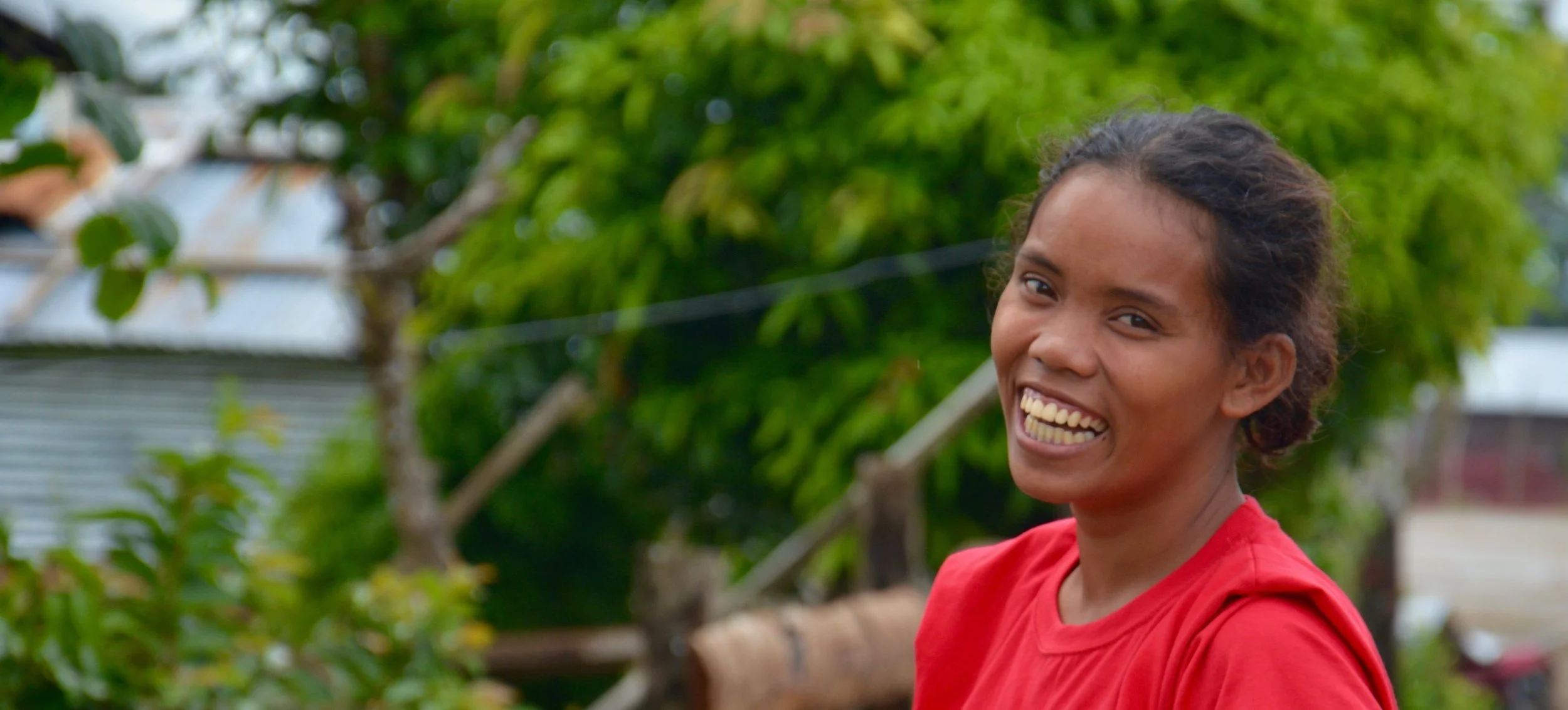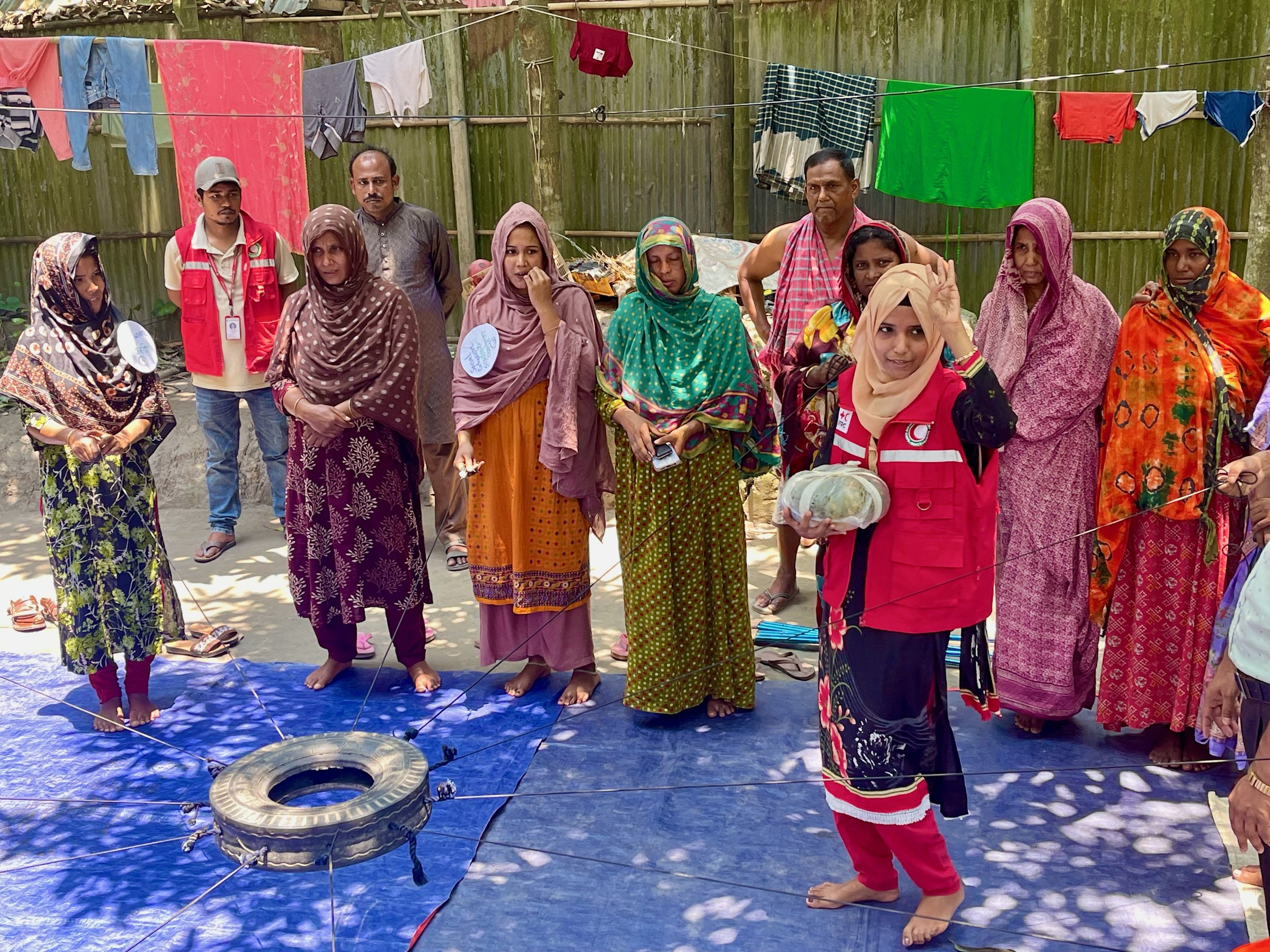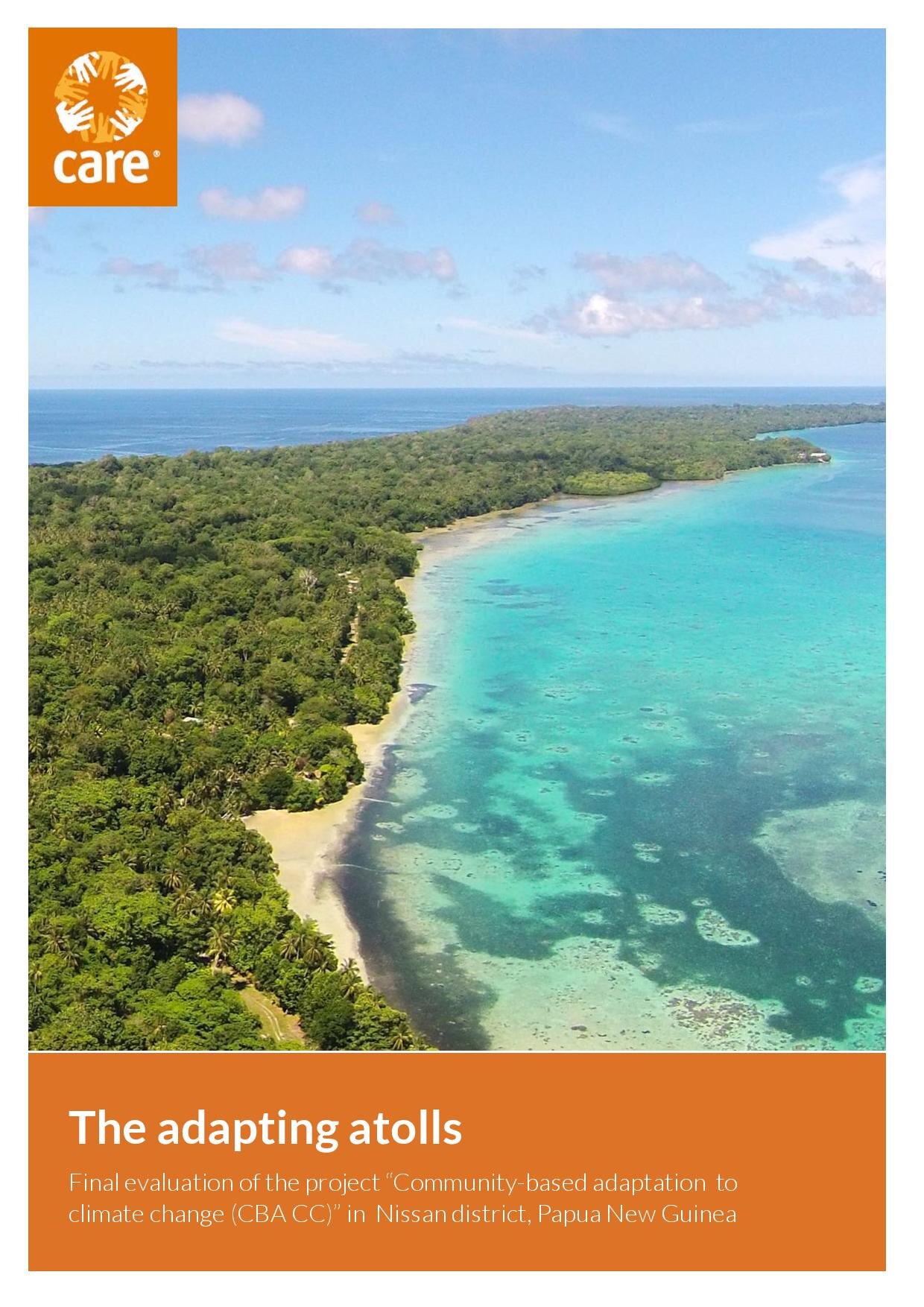TowardS tighter ropes
In two studies for Swiss Red Cross — a project evaluation and a baseline for a successor project — we highlight what can be done to reinforce community resilience. The accelerating impact of the climate crisis is impetus to act holistically and at scale.
Resilience star: Facilitator Afsana Moni counts down before she drops a pumpkin at the start of the resilience star exercise in Paschim Lakhiar Para. The ‘pumpkin drop’ illustrates resilience: 11 villagers hold elastic ropes, each representing a dimension of resilience. The tyre at the centre represents the community, the pumpkin a hazard. If all ropes are held tightly, the tyre bounces back (it doesn’t if some or all ropes are loose). For this evaluation, we played this game at the start of resilience star exercises. It shows how the two perspectives of resilience are related: the outcome perspective (the vertical bounce-back) depends on the functional perspective (the tightness of the horizontal ropes). In essence, measuring resilience is checking how tight the ropes are.
Conducted during sweltering heat in May 2024, the twin studies for Swiss Red Cross (SRC) highlight an effective approach of strengthening community resilience, as well as the urgent need for adaptation to climate change.
The evaluation of the RRR project, implemented by Bangladesh Red Crescent Society (BDRCS) and SRC between 2021 and 2024, is a powerful case study. With holistic programming and integral aspects to enhance the functions and connections of communities, the RRR project contributed to strong advances to community resilience. The evaluation noted a 61.3% increase in the average resilience score, as measured through the survey-based resilience radar. All social dimensions (community capacity, connectedness, social capital, and inclusion) are now rated as very high, representing a strong foundation that communities can build on.
The baseline study for the new Jamuna project, meanwhile, illustrates extreme levels of vulnerability and sensitivity to climate stressors in the new target area. Using the IFRC versions of the resilience radar (survey-based) and resilience star (discussion-based), the study identifies an average resilience score is just 0.32 (range: minimum 0.00 to maximum 1.00), and thus much lower than equivalent baseline scores for previous projects by BDRCS and SRC. The communities already experience strong effects of the climate crisis (increased frequency of human and animal diseases and crop failures were the most cited). However, knowledge of the climate crisis itself and of ways to adapt to it is very limited.
A summary of the two studies is also available.
At the frontlines of the climate crisis: a climate resilience study that our team prepared for Danish Red Cross is now available. Afghanistan, Nepal, Bangladesh, and Myanmar: Creeping climate stresses and more frequent extreme weather events already push communities to the edge, testing and at times exceeding their coping capacities.
The study identifies eight patterns and illustrates the urgent need for bold action. As projections show that a warmer world means that regional climates will be warmer, wetter, wilder, and drier in the decades to come, the study offers guidance for a modular programme to raise climate resilience in the four countries.
For the study, Patrick Bolte travelled to Afghanistan and Bangladesh and Samadhi Marr to Nepal. Su Myat Yin Chaw contributed research on Myanmar. In identified climate hotspots such as Satkhira district of Bangladesh, they explored with communities the impact of climate change, as well as potential solutions to strengthen climate resilience.
The report includes an analysis of policies and possible partners for a new Danish Red Cross climate resilience programme, and culminates in a proposed modular programme outline.
A summary of the report is available here.
2023 DRR Summer School
In 2023, Banyaneer and Oxford Brookes University for a truly exciting event.
To be amongst the first to hear about similar events in the future, register your interest by clicking on the button below.
This July, Banyaneer and Oxford Brookes University brought together five of the pioneers of DRR with 32 researchers and practitioners. Ian Davis, Terry Cannon, David Alexander, Maureen Fordham and John Twigg shared their insights and experiences and discussed with participants some of the most challenging aspects in disaster risk reduction.
To learn more about the DRR Summer School 2023, head to the website drr2023.com.
If you’d like to join similar events in the future, register your interest here — and you’ll hear from us as soon as the next event is coming up.
Reduce risk with nature.
A new handbook that we helped prepare for IFRC guides users to the most suitable nature-based solutions.
Since we started in 2010, nature has been part of our work to help raise resilience (it’s even in Banyaneer’s name). Our very first evaluation looked at a large-scale mangrove afforestation project in Vietnam (see IFRC 2011). Over the years, we analysed and advised efforts in which risk was reduced through nature in Cambodia, Timor-Leste, Papua New Guinea, and Myanmar. In 2021, we wrote The Blue Guide (The Nature Conservancy 2021), a guide on the use of nature-based solutions (NbS) in coastal settings.
The Nature Navigator (IFRC 2022) stands in that continuum and aims to inspire, guide, trigger, enhance, and enable action in reducing risk with nature. The handbook offers starter options (to raise awareness through action, as a stepping stone to think bigger), more advanced options in natural resource management (NRM) and nature-based solutions (NbS), and a section on the role of nature in disaster response and recovery.
Aligned with IFRC’s Road Map to Community Resilience, the Nature Navigator features an interactive format, case studies, one-page solution factsheets, as well as two toolboxes for the application of NbS and the facilitation of related trainings.
The public draft version is now available — following feedback from users, the final version will be created in 2023. To learn more about NbS, head to the IFRC NbS page and see key resources on our new NbS section. Our gratitude goes to the IFRC NbS team for excellent collaboration.
Questions
-
It depends. Nature-based solutions should meet certain standards defined by IUCN, and typically should create net benefits to ecosystems and to communities.
Planting a few trees in your backyard is not an NbS. Planting trees as part of broader forest or watershed restoration is typically an NbS.
Learn more in The Nature Navigator.
-
In many ways. NbS are essentially about sustaining and/or restoring ecosystems and the services they provide (just think of the breath you take while reading this sentence).
NbS offer protective benefits (e.g., a restored watershed can reduce flood risk). They can also bring many other tangible benefits and contribute to greater food and water security, health, and livelihoods.
Communities typically grow more resilient when they take ecosystem considerations into account through NbS and environmental stewardship.
Chapter 1 of the Nature Navigator (‘Foundations’) gives several examples.
Also related to nature-based solutions:
A Level Up.
Many projects aim to ‘build resilience’. But how do you measure the level of resilience?
We developed the resilience radar and refined other tools to gauge resilience (and project impact).
Our evaluation report for Swiss Red Cross that looked at a project in north-western Bangladesh showed remarkable results.
Raising resilience is a key task in humanitarian and development efforts — but how do you actually know whether your efforts have been effective? In 2017, Banyaneer developed the resilience radar as a practical tool that can be integrated into base- and endline surveys. In the same year, we applied the tool in conjunction with its qualitative sister (the resilience star) for the baseline of a disaster risk management project in Bangladesh’s flood-prone Gaibandha district.
We came back in 2021 for the endline and evaluation, and noted that resilience had increased on all measured dimensions — most notably in the areas that had been at the heart of the Bangladesh Red Crescent and Swiss Red Cross project (see illustration below).
Our report (‘A level up’) includes the first application of the resilience radar in a longitudinal comparison, and also commends the project team on strong efforts towards greater connectedness with local governments.
In 2022, we have applied a second longitudinal comparison in the context of a slum resilience project north of Dhaka. We also contributed to the development of IFRC’s resilience measurement dashboard, which features adjusted versions of resilience radar and resilience star as well as an interactive analysis suite.
Questions
-
Resilience can be seen from two perspectives: the outcome perspective is about the depth and length of a downturn in the wake of a crisis or disaster (i.e., what are the damages and losses, and how quickly does the community recover?).
The functional perspective looks at the characteristics a community needs to have to anticipate, adapt to, deal with, and recover from the impacts.
The resilience radar looks at the functional perspective and is based on a survey that translates responses into numerical values. On each dimension, there is a maximum score of 1.0 and a minimum of 0.0. As shown in the illustration, connecting these scores creates the resilience pattern, which can be compared between base- and endlines.
-
To measure resilience, it is prudent to apply mixed-method approaches. So in addition to the survey-based resilience radar, it is useful to apply qualitative tools such as the resilience star (based on focus group discussions), EVCA tools such as seasonal calendars and risk mapping, and resilience scans (which captures secondary information).
Collating data from different sources helps to understand the full picture and design targeted approaches to raise resilience.
-
We provide solutions for every stage of the project management cycle. We co-design projects, conduct needs assessments and baselines (using resilience measurement tools), mid-term reviews and evaluations.
At Banyaneer, we strongly believe in capturing and harnessing local knowledge and in developing projects that accompany, connect, and enable (ACE) communities.
Featured reports
How can you pursue DRR efforts in times of a pandemic while also addressing new needs? This was one of the key questions at the Africa Regional Workshop on Disaster Risk Reduction that we facilitated in late 2020 for German Red Cross (GRC).
Funded by the German Federal Foreign Office, the workshop was brought to life by practitioners from 10 countries. Their answers to practical challenges were inspirations, and showed their ingenuity at quickly adapting to the changing context.
After covering common challenges and issues in week 1, participants presented case studies of their approaches in week 2. They selected the top six studies, which are included in the report. They include the roll-out of soap and mask production, tippy taps as well as ways to reduce risk and adapt to climate change (for instance by creating the half-moons pictured on the report cover), and many others.
Disasters damage, destroy, kill. What difference does disaster risk reduction make? This study analyses the impact that various Red Cross interventions have generated by promoting better household and community preparedness. It identifies quantifiable benefits that exceeded project cost between 2.6 and 16.6 times, and indicates what measures worked best.
The strong adoption of household preparedness measures was seen as a result of three factors - first, effective awareness-raising by Red Cross volunteers, second, critical mass as a proportion of the overall village population, and, third, recent personal experiences of major hazards (93.8% of survey respondents said they recognised the value of being prepared more in the aftermath of disasters). Somewhat overlapping with the third factor was a high frequency of natural hazards.
The analysis of early warning systems showed that on their own, both the traditional early warning system (‘chowkedar’) and the government SMS alert system have their gaps — less than half the population (41.8%) were reached by either system in 2014. Complementing these systems with NRCS volunteers spreading messages via megaphones, as supported by the project, meant that almost three quarters (74.1%) were reached. Ensuring that equipment works and that volunteers can be quickly mobilised is therefore seen as a factor of success.
Set in on two remote atolls in eastern Papua New Guinea, CARE’s project ‘Community-based Adaptation to Climate Change in Nissan District (CBA CC) was launched in mid-2012 to increase the community adaptive capacity and resilience to existing hazards and the impacts of climate change. This evaluation demonstrates that the project raised capacity and resilience — and notes a strong positive impact on food security, organisational capacity, as well as progress towards more equitable gender relations at the household level.
The project’s implementation approach - using core groups trained in a wide range of agricultural techniques which then disseminated knowledge across all villages - was found to be highly effective. The merit of these groups was recognised by local government, which developed plans to integrate them into formal governance structures.
The evaluation confirmed that the process of adaptation to both climate change and challenges in natural resource management takes time. While the project provided solid groundwork, the evaluation called for efforts to sustain the livelihoods of the people on Nissan and Pinepal islands into the future. This concerns both structural measures (additional rainwater tanks) as well as organizational strengthening - capacity-building of the Nissan District Administration (NDA) is seen as particularly crucial to further raise the islanders’ adaptive capacity.
All of our reports are rigorously researched and professionally presented. See our reporting principles and past reports here.
Opinion
Lessons from Bali
Banyaneer was on Bali this May to attend the Global Platform on Disaster Risk Reduction (GPDRR).
Efforts ro reduce risk and to ‘stop the spiral’ must be upscaled and more concerted.
Patrick Bolte
The President of Indonesia Joko Widodo speaks during the opening ceremony of the GPDRR.
After two years of pandemic-induced Zoom gloom, it felt great being out again in the ‘real world’. The Global Platform for Disaster Risk Reduction (GPDRR) have been rich in insights and debates (meeting old and new colleagues beyond the screen is an added benefit). Here are some of my initial reflections.
1. Break the silos. Break containers too.
Several presenters and participants rightly urged to 'break the silos' of the sectors, calling for systems perspectives and comprehensive approaches to risk. That is right and in line with the latest GAR, which calls for moves to systemic risk governance. It is perhaps not without irony that such calls come from the silo-esque nature of a DRR conference (although there are positive trends of convergence among actors, for instance between organisations working on ecosystem restoration and typical DRR actors).
Systemic risk governance would need to be even broader in terms of topics, stakeholders, and processes (the end of DRR as we know it). It will be increasingly risky out there — the GAR warns that we may see 1.5 medium to large-scale disasters every day in the 2030s.
Aside from the sectoral silos (which are vertical), I'd like to propose that we often face another barrier to more effective DRR efforts: (horizontal) containers. While some organisations work primarily through governments (for instance, the World Bank or UNDP), others work primarily through communities (e.g. most NGOs and Red Cross/Red Crescent Societies). There is often some alignment between community-based and government-centric efforts, but I believe these could be much stronger by design (mutually reinforcing components or broader programme designs).
It's time to get out of our comfort zones and seek new partnerships to raise resilience.
















